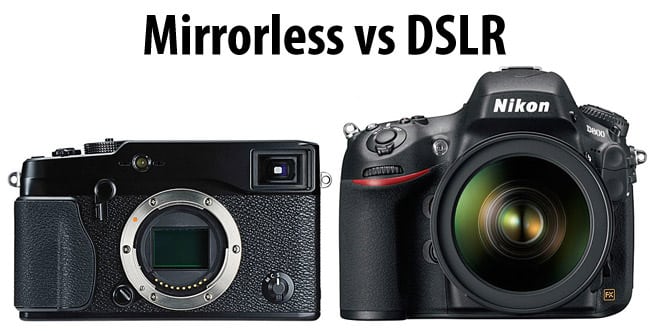DSLRs and mirrorless cameras, often known as mirrorless interchangeable-lens cameras (MILCs), are 2 popular types of digital cameras known to us. Up until now, the supremacy of DSLR in the area of delivering high-level image quality and shooting experience was unchallenged. The MILC, which started as a small and new category of cameras, slowly came around to be the camera that dared to challenge the supremacy of the DSLR. They have equally sized sensors and both of them come with some of the sharpest and best-built lenses in a much smaller and lighter form factor. Here we list some pros and cons of each of the two type of camera to help you make an informed decision depending on your requirements.
Table of Contents
DSLR Camera Pros
When a photographer looks into the viewfinder of a DSLR camera, he can say exactly what is going to be captured by the camera. This is a huge advantage compared to MILCs, as with MILCs photographers have to rely on ‘live’ LCD screens at the back of the camera or electronic viewfinders to capture the photograph, so what one sees isn’t always exactly what one is shooting. In the case of AF, the performance of DSLR is completely unrivalled.
Speed is also a huge advantage of DSLR cameras. They focus faster even in low lighting thus making it easy to capture fast-moving subjects. They also allow fast zooming. Finally, DSLR cameras have simply been on the market for much longer which means that there are more lenses and more camera equipment specifically designed for DSLRs.
Mirrorless Camera Pros
The most imminent advantage of mirrorless cameras is their small size. As a matter of fact, many models aren’t much larger than traditional point-and-shoot models. Since they are smaller, they are much more discreet than a DSLR. If the photographer wants to capture candid shots then carrying a small MILC is much easier than operating a DSLR with a huge lens. And also because lenses are much smaller, it is easier to bring various different lenses along on a photo shoot.
In addition, MILCs have fewer moving parts compared to DSLR. This makes them much more robust and a little less likely to get damaged. MILCs are also quieter upon shutter activation, owing to its mirror-less factor. Even though mirrorless cameras have fewer choices of lenses in the market they are of top quality and have different focal lengths.
DSLR Camera Cons
As mentioned before DSLRs are bulky. The primary shortcoming of DSLR cameras is their size and magnitude. They are much heavier than MILCs cameras and cumbersome to carry easily anywhere. Lenses are also big, so carrying around a bunch of different lenses isn’t always a feasible option. DSLRs can also be a bit complicated to learn because of all of their different buttons and features hence it is advisable to get proper training.
Mirrorless Camera Cons
MILCs are new players on the professional camera scene. While the technology behind them has drastically improved in recent years, it is just not as established as DSLR technology in the market. Although the prices have been receding recently, especially with Nikon’s recent release of their first MILC, they are reasonably high for the common man.
As already mentioned, MILC photographers have to rely on ‘live’ LCD screens at the back of the camera or electronic viewfinders to capture the photograph. It can affect accuracy— what you are seeing isn’t always necessarily what you are shooting.
Also, MILCs have a slower focus speed than DSLR. This means that one could potentially run into some problems when trying to capture a fast-moving shot. In situations where a millisecond can make a huge difference in your shots, MILCs are simply not a good option.

